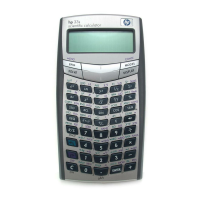7–2 Solving Equations
File name 33s-E-Manual-1008-Publication(1st).doc Page : 386
Printed Date : 2003/10/8 Size : 13.7 x 21.2 cm
If the displayed value is the one you want, press
¥
.
If you want a different value, type or calculate the value and press
¥
.
(For details, see "Responding to Equation Prompts" in chapter 6.)
You can halt a running calculation by pressing
Å
or
¥
.
When the root is found, it's stored in the unknown variable, and the variable value
is VIEWed in the display. In addition, the X–register contains the root, the
Y–register contains the previous estimate, and the Z–register contains the value of
the equation at the root (which should be zero).
For some complicated mathematical conditions, a definitive solution cannot be
found — and the calculator displays
. See "Verifying the Result"
later in this chapter, and "Interpreting results" and "When SOLVE Cannot Find a
Root" in appendix D.
For certain equations it helps to provide one or two initial guesses for the unknown
variable before solving the equation. This can speed up the calculation, direct the
answer toward realistic solution, and find more than one solution, if appropriate.
See "Choosing Initial Guesses" later in this chapter.
Example: Solving the Equation of Linear Motion.
The equation of motion for a free–falling object is:
d = v
0
t +
1
/
2
g t
2
where d is the distance, v
0
is the initial velocity, t is the time, and g is the
acceleration due to gravity.
Type in the equation:
Keys: Display: Description:
¹
¡
{
} {
}
Clears memory.
º
d
or current equation
Selects Equation mode.
h
D
º
¢
h
V
¸
h
T
Ù
Starts the equation.
.5
¸
h
G
¸
h
)
2
_
Ï
Terminates the equation

